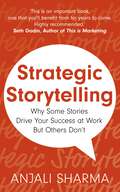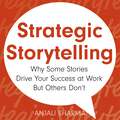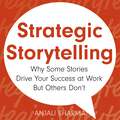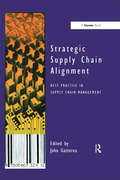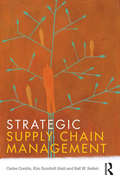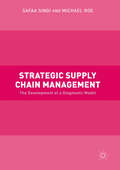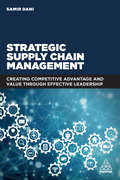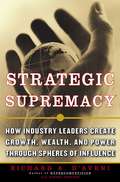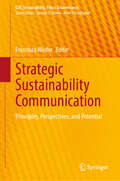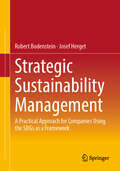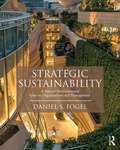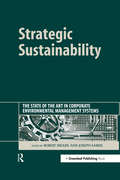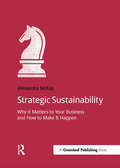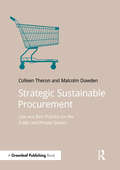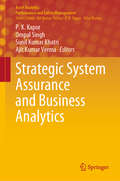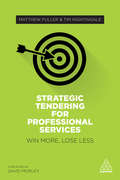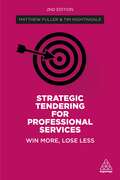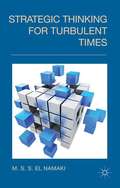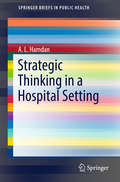- Table View
- List View
Strategic Stories: How 3M Is Rewriting Business Planning
by Robert Brown Gordon Shaw Philip BromileyThis article argues that a good strategic plan must be written in a narrative form that tells an exciting, detailed, nuanced story. Virtually all business plans are written as a list of bullet points. Despite the skill or knowledge of their authors, these plans usually aren't anything more than lists of "good things to do." Rarely do these lists reflect deep thought or inspire commitment. Worse, they don't specify critical relationships between the points, and they can't demonstrate how the goals will be achieved. 3M executive Gordon Shaw began looking for a more coherent and compelling way to present business plans. He found it in the form of strategic stories. Telling stories was already a habit of mind at 3M. Stories about the advent of Post-it Notes and the invention of masking tape help define 3M's identity. They're part of the way people at 3M explain themselves to their customers and to one another. Shaw and his coauthors examine how business plans can be transformed into strategic narratives. By painting a picture of the market, the competition, and the strategy needed to beat the competition, these narratives can fill in the spaces around the bullet points for those who will approve and those who will implement the strategy. When people can locate themselves in the story, their sense of commitment and involvement is enhanced. By conveying a powerful impression of the process of winning, narrative plans can mobilize an entire organization.
Strategic Storytelling: Why Some Stories Drive Your Success at Work But Others Don’t
by Anjali SharmaIn today's connection economy, the most successful leaders inspire their people with purpose and meaning. Powerful corporate storytelling can mobilise people around an organisational objective in a way that a focus on market share never will. Be it a digital transformation or a diversity and inclusion initiative, corporate change needs the support of the people in that organisation in order to stick.Yet, while all stories can move people to take action, storytelling isn't a one size fits all. The most effective influencers learn to flex their narrative based on the audience's time or their level of expertise.A story that works on the stage doesn't work in the boardroomA story that works in the boardroom doesn't work in a team meetingA story that works in a team meeting doesn't work in a one-to-one conversation A story that works in one-to-one conversation doesn't work in sales...Anjali Sharma introduces leaders and ambitious influencers to the Who, Why and How of strategic storytelling in business, enabling them bring about change and drive corporate success by telling exactly the right story in the right way.
Strategic Storytelling: Why Some Stories Drive Your Success at Work But Others Don’t
by Anjali SharmaHow to use storytelling to motivate people in your organisation, drive results and advance your careerIn today's connection economy, the most successful leaders inspire their people with purpose and meaning. Powerful corporate storytelling can mobilise people around an organisational objective in a way that a focus on market share never will. Be it a digital transformation or a diversity and inclusion initiative, corporate change needs the support of the people in that organisation in order to stick.Yet, while all stories can move people to take action, storytelling isn't a one size fits all. The most effective influencers learn to flex their narrative based on the audience's time or their level of expertise.A story that works on the stage doesn't work in the boardroomA story that works in the boardroom doesn't work in a team meetingA story that works in a team meeting doesn't work in a one-to-one conversation A story that works in one-to-one conversation doesn't work in sales...Anjali Sharma introduces leaders and ambitious influencers to the Who, Why and How of strategic storytelling in business, enabling them bring about change and drive corporate success by telling exactly the right story in the right way.(P) 2023 Hodder & Stoughton Limited
Strategic Storytelling: Why Some Stories Drive Your Success at Work But Others Don’t
by Anjali SharmaHow to use storytelling to motivate people in your organisation, drive results and advance your careerIn today's connection economy, the most successful leaders inspire their people with purpose and meaning. Powerful corporate storytelling can mobilise people around an organisational objective in a way that a focus on market share never will. Be it a digital transformation or a diversity and inclusion initiative, corporate change needs the support of the people in that organisation in order to stick.Yet, while all stories can move people to take action, storytelling isn't a one size fits all. The most effective influencers learn to flex their narrative based on the audience's time or their level of expertise.A story that works on the stage doesn't work in the boardroomA story that works in the boardroom doesn't work in a team meetingA story that works in a team meeting doesn't work in a one-to-one conversation A story that works in one-to-one conversation doesn't work in sales...Anjali Sharma introduces leaders and ambitious influencers to the Who, Why and How of strategic storytelling in business, enabling them bring about change and drive corporate success by telling exactly the right story in the right way.(P) 2023 Hodder & Stoughton Limited
Strategic Storytelling: Why Some Stories Drive Your Success at Work But Others Don’t
by Anjali SharmaIn today's connection economy, the most successful leaders inspire their people with purpose and meaning. Powerful corporate storytelling can mobilise people around an organisational objective in a way that a focus on market share never will. Be it a digital transformation or a diversity and inclusion initiative, corporate change needs the support of the people in that organisation in order to stick.Yet, while all stories can move people to take action, storytelling isn't a one size fits all. The most effective influencers learn to flex their narrative based on the audience's time or their level of expertise.A story that works on the stage doesn't work in the boardroomA story that works in the boardroom doesn't work in a team meetingA story that works in a team meeting doesn't work in a one-to-one conversation A story that works in one-to-one conversation doesn't work in sales...Anjali Sharma introduces leaders and ambitious influencers to the Who, Why and How of strategic storytelling in business, enabling them bring about change and drive corporate success by telling exactly the right story in the right way.
Strategic Supply Chain Alignment: Best Practice in Supply Chain Management
by John GattornaSupply chain performance will be a key indicator of overall corporate success into the next century. This book, edited by logistics and supply chain expert John Gattorna, and with international contributions, presents unpublished material on next generation thinking about the management of the supply chain. Based on the recently developed strategic alignment model it shows how external market dynamics, the company’s strategic response, and internal capability must be aligned if competitive advantage is to be achieved. Supply chain management is a strategic challenge demanding top level management attention. This book tackles the subject at that strategic level to help companies reposition their supply chains successfully. The book then offers the vital link between strategy setting and implementation, providing comprehensive coverage of the main areas of execution, and making it an essential compendium on all aspects of the subject. With case studies from major organizations from around the world, it is a ’must’ read for anyone wishing to be at the forefront of international supply chain management thinking. Strategic Supply Chain Alignment brings together for the first time the world’s leading logistics professionals, management consultants and academics to offer their insights and experiences on the latest supply chain management techniques. This collection of previously unpublished material offers the reader a unique opportunity to identify the hot issues, discover emerging strategies and uncover key industry and market perspectives. Divided into five sections which reflect the important components of the strategic alignment model, the book covers: ¢ The market: Customer value creation and segmentation, and the rationale behind the integration of supply with demand. ¢ Strategic response: Considers channel strategy, supply chain configuration and operations and distribution management. ¢ Culture: Adopting organization options which focus on deliv
Strategic Supply Chain Management
by Carlos Cordón Kim Sundtoft Hald Ralf W. SeifertThe supply chain is at the heart of every successful business organization's decision-making process. This textbook explains how to create a winning supply chain management strategy by spotlighting how senior executives in European and US companies have turned their supply chains into strategic weapons designed to convert threats, risks and outside pressures into competitive advantages. Strategic Supply Chain Management contains twenty real-world cases, all of which have been field researched by a top author team and tested out in the classroom. Each case adopts an executive leadership perspective to illuminate the real dilemmas faced by managers. The authors draw on their extensive classroom and industry experience to ensure that the writing style is geared towards an executive education readership. This elite case package will provide a complete teaching resource and authentic learning experience for MBA and executive education classes in Supply Chain Management throughout the world.
Strategic Supply Chain Management
by Michael Roe Safaa SindiThis book analyses the development of strategic supply chain modelling and its role in optimising decision-making in business, in relation to advances in technology and increased demand due to globalisation. The authors examine existing supply chain models in order to create a conceptual framework for a new diagnostic tool, offering a useful, realistic and meaningful contribution to the field, both theoretically and practically. Using the real-life context of a major international automobile manufacturer, this study satisfies the demand from industry for guidance in the complex world of strategic supply chain modeling in the growing logistics business sector. Readers of Strategic Supply Chain Management will find this work instructive and informative, and it will be of particular interest to students, researchers and policy-makers in the supply chain management industry.
Strategic Supply Chain Management (EAI/Springer Innovations in Communication and Computing)
by Zhang Yu Syed Abdul KhanThis book covers the scope of supply chain and logistics, which has continued to grow with a rapid speed. The book includes core aspects of supply chain and logistics philosophy and practice. The authors then cover the general principles of supply chain and logistics that can be applied in countries throughout the world. Where concepts cannot be generalized, they are based primarily on a European model. The authors have also added some international material and examples from China, Pakistan, India, and the USA. The book is intended to help in the quest of supply chain and logistics to reduce cost and improve service, as well as to keep up-to-date the different facets of supply chain and logistics in a global market. In addition, this book helps candidates to who are undertaking examinations for universities and professional institutes, and bachelor and master students who are studying for degrees in supply chain management. In addition, the book covers technical terminologies, definitions, and a supply chain dictionary.
Strategic Supply Chain Management: Creating Competitive Advantage and Value Through Effective Leadership
by Samir DaniSupply chains, including logistics, are the functional elements of an organisation's operations. To formulate a strategy for this operation to work seamlessly the organisation needs to align these operations with the corporate and business strategy. Strategic Supply Chain Management provides a discussion on effective supply chain strategic leadership for managerial teams who have previously been operating on a tactical or operational level, as well as students who need to learn about applying the theories of strategic supply chain management in practice. Strategic Supply Chain Management introduces concepts and tools which will enable successful buyer-supplier relationships and effective organizational leadership and talent management. Samir Dani provides a concise but important outlook on the connection between business strategy and supply chain strategy. The book delves into topical issues of risk, resilience, and sustainability and how these influence both business and supply chain strategy. The book also considers strategies for procurement, buyer supplier relationships, and sales & operations planning. An important aspect of this book is to consider the leadership and talent aspects of the humans in the supply chain and how this influences strategy and creates competitive advantage.
Strategic Supremacy
by Richard A. D'AveniAre upstart competitors taking deadly aim at your company's products and markets? Richard A. D'Aveni, author of the famous attacker's handbook Hypercompetition, presents coun-terrevolutionary strategies and tactics that any industry leader or established company can use to defend itself against revolutionaries, disrupters, or hypercompetitors. The secret lies in making the rules, not breaking them, D'Aveni says, because rule makers still rule. Arguing that "profits and prosperity come not from revolution but stability and orderly change," D'Aveni presents a commanding framework that will enable any resource-rich or clever defender to gain Strategic Supremacy by being first to define the playing field. D'Aveni demonstrates how global powerhouses such as Disney, Microsoft, and Procter & Gamble have achieved preeminence by reconceptualizing their product portfolios as powerful competitive arsenals he calls "spheres of influence." Essentially a new way to compete by restructuring portfolios around a core geographic/product market, spheres enable any company to influence the behavior and positioning of rivals. In immensely readable prose, D'Aveni describes how prevailing spheres of influence can be used to create legal business equivalents to a "concert of powers" and other industry structures that mix cooperation with competition. Just one of the potent functions of a corporate sphere, D'Aveni shows, is to contain competitors of equal size (as NBC contained ABC). Spheres can also be used to stabilize an entire industry's global power system. A glance at the detailed table of contents will provide a sense of the wealth of new information contained in this essential handbook of global warfare, including "how-to" tools the reader will need to measure and map the pattern of competitive pressure in any industry and to interpret the meaning and strategic implications of these pressure patterns for his or her position within the industry's power hierarchy.
Strategic Sustainability Communication: Principles, Perspectives, and Potential (CSR, Sustainability, Ethics & Governance)
by Franzisca WederThis book discusses the evolution of the sustainability story in corporate, political, and environmental discourses as well as paradigms and theoretical approaches to better understand communication about, of, and for sustainability. The book aims to be a preferred resource for academics, scholars, students as well as practitioners in environmental management, communication management, journalism as well as sustainability studies. The authors elaborate on various conceptual perspectives on strategic sustainability communication and offer practical examples and exercises for making sustainability and related issues accessible and comprehensible, for co-creating social change and taking authorship in new emerging professions like Sustainability Manager and Officer. Furthermore, the volume explores methodological as well as pedagogical innovations, complemented by case studies and interviews around existing strategies and tactics to create sustainable solutions (communication planning, campaigning, messaging, etc.). Thus, it offers students and instructors as well as (future) communication strategists and campaigners foundations, strategies, tools, and methodologies of communication for transformation and co-creation of alternative narratives. Professionals, advocates, and academics are attracted who are passionate about taking proactive roles in restoratively addressing the pressing interrelated sociocultural and ecological issues of our times and seek to be reflexive leaders and advocates.
Strategic Sustainability Management: A Practical Approach for Companies Using the SDGs as a Framework
by Josef Herget Robert BodensteinThis book provides a practical guide to implementing sustainability strategies within companies. It introduces a model-based approach that enables a comprehensive, yet focused strategy, ensuring that complexity doesn’t overshadow the core objectives. The concept of Sustainability Excellence offers a versatile methodology, designed to meet the needs of both large corporations and small businesses with limited resources. The approach is adaptable to various sustainability frameworks and strategies. To demonstrate its application, the book uses the United Nations’ Sustainable Development Goals (SDGs) as a concrete example of how the method can be put into practice. Special emphasis is placed on integrating the sustainability strategy into the corporate culture, ensuring it becomes a fundamental part of the organization's DNA. The book is enriched with practical tools, including checklists and insights into the opportunities and risks of sustainability management. It is a valuable resource for managers, business owners, consultants, and anyone interested in shaping effective sustainability strategies within their organizations.
Strategic Sustainability: A Natural Environmental Lens on Organizations and Management
by Daniel S. FogelStrategic Sustainability examines how organizations can implement environmental sustainability science, theories, and ways of thinking to become more competitive. Including examples and ideas implemented in various countries, it is based on known scientific principles about the natural world and organizational principles focusing on the work domain. The intersection of these two realms of research creates a powerful and new approach to comprehensive, seemingly contradictory issues. Daniel S. Fogel draws from disparate fields and creates a story about organizations, their future and how people are part of the problem and, more importantly, part of the solution. Readers will find ways to take action to improve organizations and avoid denigrating our natural environment, learning to be mindful of the urgency we should feel to improve our impact on the world. The focus on the natural environment provides a powerful focus for creating value in organizations and addressing the major challenges we all face. Advanced sustainability students, working professionals and board members, managers and legislators responsible for governing organizations or implementing public policy will find this book useful. A companion website features an instructor’s manual with test questions, as well as 38, 10-minute videos for classroom use.
Strategic Sustainability: The State of the Art in Corporate Environmental Management Systems
by Robert Sroufe Sarkis JosephThe last decade has seen increasing awareness of the importance of understanding corporate environmental management systems (EMSs) and their relationships with sustainability, competitiveness and institutional practice. It is now assumed that most large companies have some version of an EMS in place with systems ranging from informal policies and practices to formalised third-party certified systems that are widely publicized by companies and are now integral to their strategic direction. No matter what level and type of system a firm chooses, both practitioners and researchers wish to examine and better understand the extent to which these systems are cross-functional, how they impact on performance evaluation, their capability to monitor supply chains and the life-cycles of products and services and, most importantly, whether these systems actually make a contribution to better environmental performance. This book provides intriguing insights into strategic and sustainable EMSs. It provides clear evidence of benefits that should exceed the costs (tangible and otherwise), and help practitioners understand the attributes of well-developed and strategically focused EMSs. It also demonstrates the link to performance measures such as reputation, improved position in the marketplace, cost, quality, waste reduction and numerous sustainable development-based metrics and issues. The comprehensive scope of topics spans several industries and provides environmental systems insight involving sustainable management systems, strategic and operational impacts of environmental systems, cross-country comparisons of EMS design processes and results, product-based environmental systems, EMS impacts at innovative organisations and environmental systems integration within specific industries. The book is split into three sections. First, the book covers the broad issues of planning and designing an EMS and includes topics such as performance evaluation, comparisons between multinational environmental systems, sustainable development and links between already established quality systems and an EMS. The second section focuses on EMS implementation and operation and incorporates some corporate or industry-specific case studies. The third and final category of the book highlights the use of an EMS to evaluate business processes. Strategic Sustainability will be essential reading for both managers faced with decisions regarding their own EMSs and to researchers seeking additional insights from state-of-the-art examples for further theoretical development and testing.
Strategic Sustainability: Why it matters to your business and how to make it happen (Doshorts Ser.)
by Alexandra McKayIn many businesses sustainability is one person’s passion and responsibility. A large part of their job becomes selling sustainability to other people in the business.This book offers arguments, information and tactics will help that person get the buy-in they need to move sustainability forward in their business.Strategic Sustainability: sets out why sustainability matters to businesses – the benefits to you and your stakeholders; shows how to identify the biggest issues, impacts and wins for your business; helps you identify the resources you will need to put sustainability at the heart of your business; outlines key reasons why businesses that are not multinationals should take action on sustainability, and how to do it; looks in detail at how to integrate sustainability with business strategy and mission.Sustainability is of strategic importance to a business. This book makes an airtight case for why action is essential and how sustainability can help a business not only survive but thrive in competitive marketplaces.
Strategic Sustainable Procurement: Law and Best Practice for the Public and Private Sectors (Doshorts Ser.)
by Colleen Theron Malcolm DowdenProcurement is playing an increasingly strategic role as a lever for sustainable development and social and environmental responsibility. Greater regulation on sustainable procurement in the public sector, including significant changes to the EU Directive in April 2014, are driving this change.This comprehensive guide to sustainable procurement by practising legal experts Colleen Theron and Malcolm Dowden distils key developments in EU and UK public sustainable procurement legislation, government guidance and policy; provides an introduction to sustainable procurement more broadly; provides case studies and practical examples on contractual aspects of procurement; shows you how to set up a sustainable procurement strategy; and contributes to the development of sustainable procurement policy. There is also increased emphasis on "clean" supply chains in the private sector, as best practice seeks to mesh with public sector requirements and reduce the risk that bids for public contracts might be undermined by adverse environmental impacts or social misconduct along the supply chain.Private sector companies should act now to establish best practice sustainable procurement principles to minimize the risk of litigation; several international standards are embedding the principles of sustainable procurement into their requirements.The book also offers practical examples of what sustainable procurement entails, whether the organization is bidding for public sector contracts, in need of meeting tender requirements, looking to obtain certification for a standard, or is simply seeking to improve its supply chain management and implement best practice.
Strategic System Assurance and Business Analytics (Asset Analytics)
by Ajit Kumar Verma P. K. Kapur Ompal Singh Sunil Kumar KhatriThis book systematically examines and quantifies industrial problems by assessing the complexity and safety of large systems. It includes chapters on system performance management, software reliability assessment, testing, quality management, analysis using soft computing techniques, management analytics, and business analytics, with a clear focus on exploring real-world business issues. Through contributions from researchers working in the area of performance, management, and business analytics, it explores the development of new methods and approaches to improve business by gaining knowledge from bulk data. With system performance analytics, companies are now able to drive performance and provide actionable insights for each level and for every role using key indicators, generate mobile-enabled scorecards, time series-based analysis using charts, and dashboards.In the current dynamic environment, a viable tool known as multi-criteria decision analysis (MCDA) is increasingly being adopted to deal with complex business decisions. MCDA is an important decision support tool for analyzing goals and providing optimal solutions and alternatives. It comprises several distinct techniques, which are implemented by specialized decision-making packages. This book addresses a number of important MCDA methods, such as DEMATEL, TOPSIS, AHP, MAUT, and Intuitionistic Fuzzy MCDM, which make it possible to derive maximum utility in the area of analytics. As such, it is a valuable resource for researchers and academicians, as well as practitioners and business experts.
Strategic Talent Management
by Paul Sparrow Hugh Scullion Ibraiz Tarique Paul Sparrow Hugh ScullionWith contributions from leading scholars and practitioners, this Cambridge Companion examines the topical issue of talent management from a strategic perspective, mapping out insights from a number of related fields including strategy, organisational learning, marketing and supply chain management. The authors examine the challenges faced when viewing talent management in a global context, showing how both comparative and international HRM thinking have become increasingly important when, for example, managing talent in emerging markets or trying to globalise the talent management function. The book concludes with a valuable summary of key learning points about talent management for both practitioners and researchers, as well as a discussion of the most fruitful areas for future research. This Companion will be an essential resource for academic researchers, graduate students and practitioners of global strategic talent management.
Strategic Talent Management: Creating the Right Workforce
by Robert GreeneClearly written and providing actionable strategies, this book explores new paradigms for workforce management to enable human resource managers and the organizations where they work to thrive in today’s turbulent business environment. Robert Greene goes beyond the many human resource management books currently available, to deal head-on with the new realities of talent management, including such factors as the "gig economy" and globalization. The book focuses on attracting, developing, and effectively utilizing human capital. It begins with human capital planning, and then explores strategies and programs that can attract and retain the workforce an organization needs. A range of sizes and types of organizations and different working relationships are considered, as Greene demonstrates how to evaluate the effectiveness of strategies that fit specific contexts and will sustain the viability of an organization’s workforce into the future. Postgraduate students of human resource management, as well as current HR professionals and managers, will find this practical book an indispensable resource. PowerPoint slides and test banks are available to support instructors.
Strategic Tendering for Professional Services: Win More, Lose Less
by Matthew Fuller Tim NightingaleCompetitive bidding for work is a long-established aspect of business within the professional services and consulting sector. For many markets, pitching has become a critical element of both attracting and retaining business. Combating clients' demands and intense competition, firms that want to win and retain business need business development and marketing teams that are experts in creating compelling proposals. Strategic Tendering for Professional Services offers a masterclass in improving your pitching skills and processes.Drawing on insights from current pitch and proposal professionals and client-side procurement teams, Strategic Tendering for Professional Services provides end-to-end best practice guidance. From the crucial decision of which request-for-proposals (RFPs) to respond to, right through to the all-important face-to-face presentation and post-pitch follow-up, this practical handbook leads readers through all stages of the process on best practice and strategies for success. Packed with practical features to help readers put guidance into practice, Strategic Tendering for Professional Services also supports business-wide improvement with a clear analysis of the processes and systems available to support pitch assembly and reporting. Whether you are a bid and proposal professional looking for extra tools, a business development or marketing manager providing support and expertise to partners, or a professional wanting to improve pitching skills, this book will be key to winning opportunities that will set the firm apart.
Strategic Tendering for Professional Services: Win More, Lose Less
by Matthew Fuller Tim NightingaleWINNER: Business Book Awards 2018 - 'Selling The Dream' category (1st edition)In an increasingly competitive professional services sector, it is vital that firms have an effective tendering strategy. The advantages gained from winning and retaining clients can be transformative, and the cost of losing key tenders can be catastrophic. Strategic Tendering for Professional Services provides end-to-end best practice guidance, from the crucial decision of which request-for-proposals to respond to, right through to the all important face-to-face presentation and post-pitch follow-up. Now in its second edition, this practical book captures insights from both sides of the market through interviews with both proposal professionals and decision makers from the client side. Focusing on key considerations, including the need for diversity and inclusion, providing evidence of global citizenship and how public sector pitching differs from the private sector, this book is packed with features and tools to help professionals turn guidance into practice. Strategic Tendering for Professional Services is the essential guide to improving your pitches, honing your tendering skills and boosting your win rate.
Strategic Thinking Illustrated: Strategy Made Visual Using Systems Thinking
by Dennis SherwoodThis book is about the behaviour of systems. Systems are important, for we interact with them all the time, and many of the actions we take are influenced by a system – for example, the system of performance measures in an organisation influences, often very strongly, how individuals within that organisation behave. Furthermore, sometimes we are involved in the design of systems, as is any manager contributing to the definition of what those performance measures might be. That manager will want to ensure that all the proposed performance measures will drive the ‘right’ behaviours rather than (inadvertently) encouraging dysfunctional ‘game playing’, and so anticipating how the performance measurement system will work in practice is a vital part of a wise design process. Some of the systems with which we interact are local, such as your organisation’s performance measurement system. Some systems, however, are distant, but nonetheless very real, such as the healthcare system, the education system, the legal system and the climate system. Systems, therefore, exist on all scales, from the local to the global. And all systems are complex, some hugely so. That’s why understanding how systems behave can be very helpful. Systems are complex for two main reasons. First, the manner in which they behave over time can be very hard to anticipate – and anticipating the future sensibly is of course a key objective of management. Second, the ‘entities’ within a system can be connected together in very complex ways, so that an intervention ‘here’ can result in an effect ‘there’, perhaps a long time afterward. Sometimes this can be surprising, and so we talk of ‘unintended consequences’ – but this is of course a euphemism for ‘because I didn’t understand how this system behaves, I had not anticipated that’. Systems thinking, the subject matter of this book, is the disciplined study of systems, and causal loop diagrams – the ‘pictures’ of this ‘picture book’ – are a very insightful way to represent the connectedness of the entities from which any system is composed, so taming that system’s complexity.
Strategic Thinking for Turbulent Times
by M. S. S. el NamakiStrategic Thinking for Turbulent Times is a conceptual and operational guide to the process of business strategy formulation within a turbulence driven economic and business environment. This book features pioneering work on the process of strategic thinking after the dramatic shift in the fundamental premises of strategic management.
Strategic Thinking in a Hospital Setting
by A. L. HamdanTranslating the realities of healthcare reform and healthcare costs into competitive hospital practice is the goal of this accessible, jargon-free guide. Taking its cue from Michael Porter’s highly-regarded business strategies, it offers a sound framework for hospitals looking to develop efficient, patient-centered service delivery, identifying keys to clinical, administrative, and marketing success. The book organizes business and clinical priorities where they intersect so that physicians throughout healthcare systems can understand their role in building and sustaining innovation, and leverage their strengths and system resources toward meeting patient needs. In addition, chapters review eight core strategic tools, describe possibilities for their implementation, and provide in-depth findings on Porter’s methods as used in a diverse group of hospitals across Lebanon. Included in the coverage: · Porter’s strategies in health care: cost leadership versus differentiation strategy · Sources of competitive advantage · How to prepare an organization for innovation · Strategic framework in a hospital setting · Application of Porter’s strategies in Lebanese hospitals · Correlation between type of strategy and performanceA well-designed blueprint for enhancing patient satisfaction and system cost-effectiveness, Strategic Thinking in a Hospital Setting is aimed at both frontline physicians in practice and those assuming administrative positions in healthcare facilities and in hospital settings in particular.

